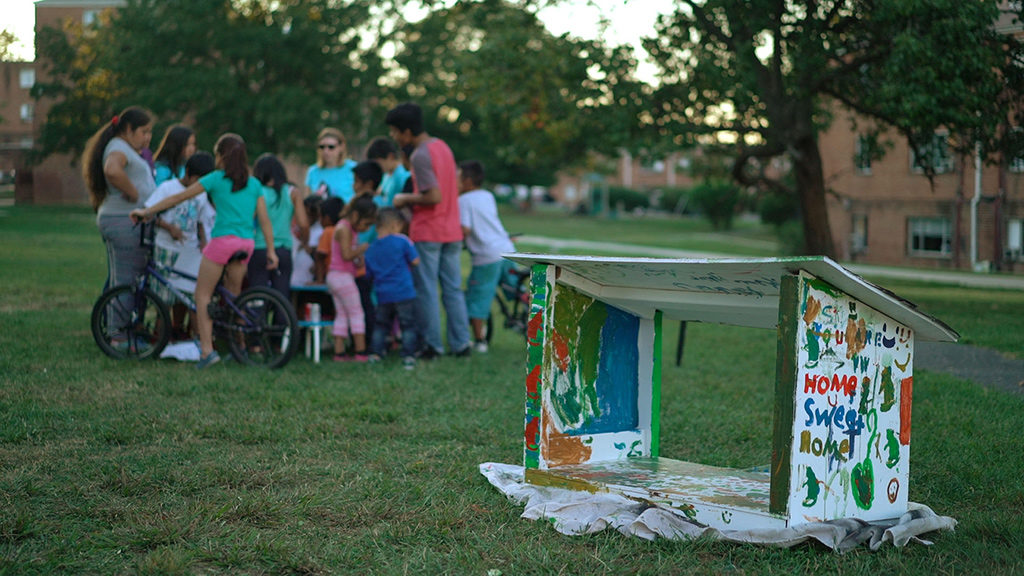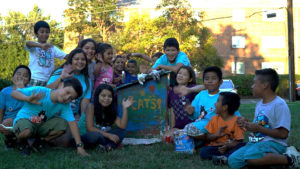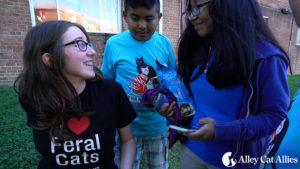Every day is an opportunity to help cats. But October 16 is an important date at Alley Cat Allies as this is National Feral Cat Day. This is when we launch our annual educational campaign with groups and individuals throughout the USA and across the world to protect the lives of all cats in all communities.
Alley Cat Allies is the world’s largest advocacy organization dedicated to the protection and humane treatment of cats. We launched National Feral Cat Day as a day of action and public education sixteen years ago. In addition to coordinating and promoting more than 1,300 events across the U.S. and 18 other countries, headquarters staff from Alley Cat Allies participated in a National Feral Cat Day action of our own. We worked with a community in Hyattsville, Md. to neuter and vaccinate their outdoor (“feral”) cats.
Outdoor Cats
The cats who live inside our homes bring us great happiness. They are beloved members of our families. But it’s easy to forget that until recently almost all cats lived outside. The invention of kitty litter some 60 years ago made it possible for cats to live exclusively indoors. Before then, all cats spent at least some, if not all, of their time outside.
Cats are a unique species. Some live entirely indoors while other household cats have access to the outside, including to enclosed porches or rooms called “catios.” Feral cats, on the other hand, live independent lives entirely outside. Their association with people is limited to caretakers who look after colonies of cats. There are even some feral cats who shun all contact with humans. As with other wild animals such as squirrels, raccoons, and birds, indoor living is not an option for feral cats. They would find it a miserable experience. Recognizing their psychological and behavioral needs is key to understanding feral cats and knowing what is in their best interests.
“Every member of the cat family, from the noble lion to the tiny black-footed cat,” writes John Bradshaw in Cat Sense, “can trace its ancestry back to a medium-sized catlike animal, Pseudaelurus, that roamed the steppes of central Asia some 11 million years ago.” While a colony of feral cats may not be exactly like a pride of lions, they deserve our care to ensure they live lives in their interests.
The best way to help feral cats is to spay or neuter them, vaccinate against rabies, and ear tip them for identification purposes, and return them to their outdoor home. This is known as Trap-Neuter-Return (TNR) or Shelter-Neuter-Return (SNR), when the local animal control or shelter works with community cat groups. TNR addresses the needs of outdoor cats and the communities in which they live. It stabilizes the population of cats and stops them from breeding along with the unwelcome behaviors often associated with intact cats. TNR greatly reduces the number of calls municipalities receive about cats. Importantly, it decreases euthanasia rates at shelters, thereby saving municipalities money, and allows animal control officers to spend their time saving animals and fighting cruelty cases.
TNR is now the mainstream approach to caring for outdoor cats. More than 600 communities in the U.S. have adopted policies embracing TNR. Caregivers in thousands of communities carry out TNR on their own, paying for food and shelter out of their own pocket, with no taxpayer support.
Proven Success
Why has TNR become so popular? Because it’s a proven success. TNR works in different climates, and in rural and urban settings. Peer-reviewed scientific research corroborates the evidence we see in communities across America.
Conversely, the conventional approach of rounding up and killing “unwanted” cats is seen to be completely unsuccessful at stabilizing cat populations. Catching and killing cats has been the dominant approach taken by the animal control and shelter system in the U.S. for more than 100 years. Catching and killing is cruel and ineffective. This is because feral cats choose to live near food and shelter, both of which are in plentiful supply in our society, particularly in urban areas. The same back alleys and dumpsters that were attractive to the cats animal control rounded up and killed will appeal to another group of cats who move in, claim the space, and rapidly reproduce. Populations rebound quickly. This pattern is evident in all animals. It’s known as the vacuum effect.
Catch and kill wastes millions of tax-paid dollars and charitable donations. It’s also unpopular as more than 80 percent of us believe that it’s more humane to leave a cat outside than to have her caught and killed.
Worldwide Prominence
Here at Alley Cat Allies we’re delighted to see the tide shifting in favor of more effective, more humane approaches to these magnificent creatures. It’s great to see National Feral Cat Day achieve worldwide prominence over the past decade. By year end, more than 5,000 events will have taken place since we established National Feral Cat Day in 2001.
It’s easy to get involved. Check out our website for activities near you. People are volunteering at spay and neuter clinics and organizing food drives. Some are building insulated houses to protect outdoor cats from the weather. Many one-day clinics will be extremely busy sterilizing and vaccinating cats. The #FeralCatDay hashtag will be trending on social media as supporters share their activities on their social networks.
Of course, helping and saving cats is something thousands of people do throughout the year, not just on National Feral Cat Day. Every day is an opportunity to help cats. There are lots of ways you can be a better ally to outdoor cats, starting with simply being aware that they exist around us and have done so for thousands of years. The next time you’re at your veterinarian or the local shelter, ask about their programs for community cats.
For many cat lovers, National Feral Cat Day is one of the most anticipated days of the year. Supporters from around the world join forces to protect and improve the lives of all cats, indoor and outdoor. The lives of thousands of cats will be saved. National Feral Cat Day helps cat caretakers build connections with each other and serves as inspiration to millions to look with greater compassion the next time an outdoor cat crosses their path.

Children and parents gather after building a feeding shelter for the cats that are a part of their community.

Children decorated a feed shelter to celebrate their community cats returning home from being TNR’d.


